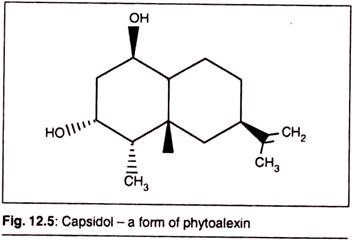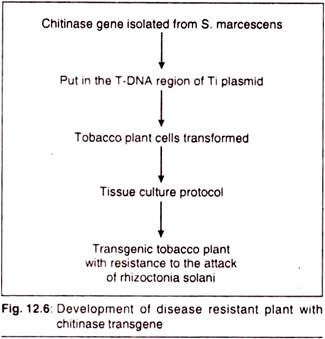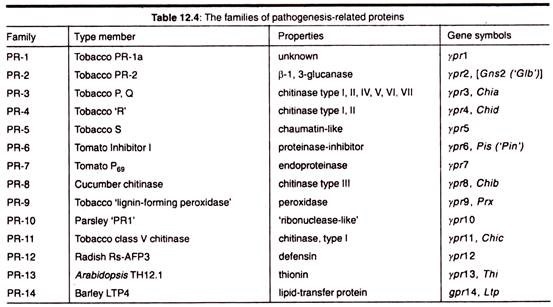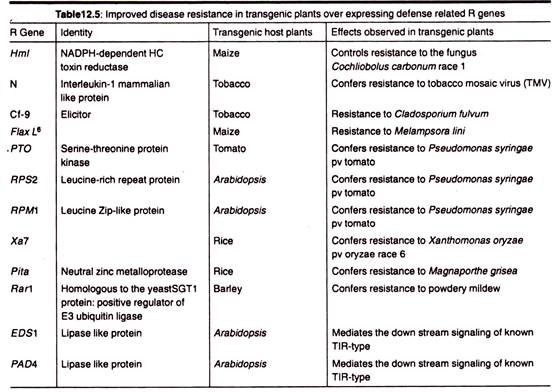In this article we will discuss about Development of Fungal and Bacterial Disease Resistance Plants:- 1. Fungal and Bacterial Pathogens 2. Molecular Basis of Plant Responses to Pathogen Invasion: Gene for Gene Relationship 3. Role of Elicitors in Plant Defense Mechanism 4. Phytoalexin 5. Phytoanticipins 6. Transgenes for Achieving Bacterial and Fungal Disease Resistant Plants.
Contents:
- Fungal and Bacterial Pathogens
- Molecular Basis of Plant Responses to Pathogen Invasion: Gene for Gene Relationship
- Role of Elicitors in Plant Defense Mechanism
- Phytoalexin
- Phytoanticipins
- Transgenes for Achieving Bacterial and Fungal Disease Resistant Plants
1. Fungal and Bacterial Pathogens:
The majority of phytopathogenic fungi belong to the Ascomycetes and the Basidiomycetes.The fungi reproduce both sexually and asexually via the production of spores. These spores may be spread long distances by air or water, or they may be soil borne.
Many soil borne spores, normally zoospores, are capable of living saprotrophically, carrying out the first part of their lifecycle in the soil. Most bacteria that are associated with plants are actually saprotrophic, and do no harm to the plant itself.
However, a small number, around 100 species, are able to cause disease. Bacterial diseases are much more prevalent in sub-tropical and tropical regions of the world.Most plant pathogenic bacteria are rod shaped (bacilli). In order to be able to colonize the plant they have specific pathogenicity factors.
2. Molecular Basis of Plant Responses to Pathogen Invasion: Gene for Gene Relationship:
At the molecular level, defense systems often depend on the combination of a specific set of dominant R genes in the plant and a corresponding set of dominant avirulence (Avr) genes in the pathogen. Expression of the Avr genes triggers plant defense responses governed by the product of the R gene.
This gene-for-gene resistance strategy underlies the molecular basis of defense systems in plants. The strategy was originally proposed by Flor in 1955 while studying resistance to the rust disease of flax.
This molecular basis is defined by a single plant R gene for a single pathogen Avr gene, hence the name gene-for-gene resistance. According to the terminology involved in gene- for-gene resistance, when the plant is resistant, the pathogen is said to be avirulent and the interaction is said to be incompatible. When the plant is susceptible, the pathogen is said to be virulent and the interaction is said to be compatible.
In a given plant-pathogen interaction, it is often possible that more than one specific combination of Avr and R genes are operating at the same time, and such different combinations are often co-dominant. These multiple combinations reflect the complexity of defense mechanisms of the plant during pathogen attack.
Physiological features affecting gene-for-gene relationship;
a. K+/H+ exchange,
b. Rapid oxidative burst,
c. Hypersensitivity at the site of infection,
d. Crosslinking of plant cell walls,
e. Synthesis of antimicrobial compounds known as phytoalexins, and
f. Induction of pathogen-related proteins such as chitinases and glucanases.
3. Role of Elicitors in Plant Defense Mechanism:
These elicitor molecules are highly specific structures, that at very low concentrations, induce plant defense responses.They are of pathogenic origin and are produced during incompatible reaction. Biochemically they are defined as inducers of the phytoalexin biosynthesis.
Followings are some examples of inducers:
a. Pathogenic peptides
b. Carbohydrates
c. Beta-glucans (especially heptaglucan)
d. Oligogalacturans
e. Chitosan
f. Fatty acids, glycosyl lipids
4. Phytoalexin:
Phytoalexins are antimicrobial substances synthesized de novo by plants that accumulate rapidly at areas of incompatible pathogen infection. They are broad spectrum inhibitors and are chemically diverse with different types characteristic of particular plant species. They can be regarded as plant’s antibiotics. Phytoalexins produced in plants act as toxins to the attacking organism.
They may result in any one of the following to stop the invasion of the pathogen in the plant;
a. Puncture the cell wall,
b. Delay maturation,
c. Disrupt metabolism,
d. Prevent reproduction of the pathogen.
5. Phytoanticipins:
Phytoanticipins are low molecular weight, antimicrobial compounds that are present in plants before challenge by microorganisms or are produced after infection solely from preexisting constituents, like phytoalexins , they play an important role in establishing a disease resistance in plants.
It is important to point out that the distinction between a phytoalexin and a phytoanticipin is not based on its chemical structure but rather on how it is produced.
Thus, the same chemical may serve as both a phytoalexin and a phytoanticipin, even in the same plant. For example, in the roots of red clover, the antimicrobial iso-flavonoid derivative maackiain is present as a compound of a preformed glucoside and is released from injured plant tissue by the action of a preformed plant glucosidase.
In this case, maackiain would be classified as a phytoanticipin. However, maackiain can also be synthesized de novo in this plant in response to microbial infection or other elicitors, making it, in this case, a phytoalexin.
6. Transgenes for Achieving Bacterial and Fungal Disease Resistant Plants:
Followings are the various types of transgenes which when introduced into the plants can confer resistant against bacterial and fungal diseases;
1. Transgenes expressing antimicrobial peptides, such as defensins and thionins.
2. Transgenes expressing bacterial lysozymes.
3. Transgenes controlling artificially controlled cell death.
4. Transgene encoding for antisense RNA (RNAi mediated control).
5. Transgene encoding for phytoalexins
6. Transgenes encoding for ribosomes inactivating proteins.
7. Transgenes encoding for enzymes which dissolves the cell wall of fungi, such as chitinase, glucanase.
Pathogenesis-Related(PR) Proteins and the Generation of Disease Resistant Transgenic Plants:
All the anti-pathogenic proteins formed in response to pathogen attack can be termed as pathogenesis related (PR) proteins. They are low molecular weight compounds. When introduced into the genome of the plant by the process of transgenesis, they have been proved to be very helpful in the control of many bacterial and viral diseases.
Some of the most important PRs have been discussed as follows;
(a) Chitinase:
This is the enzyme which is involved in hydrolysing the cell wall of chitin present in the cell wall of fungi. The chitinase, isolated from the soil bacteria, Serratiamarcescens, has been successfully cloned in tobacco plants. These transgenic plants producechitanase naturally and can prevent the attack of fungal pathogens such as Rhizoctoniasolani.
(b) Glucanase:
This is another enzyme that dissolves the cell wall of fungi. Glucanase gene isolated from barley has been successfully introduced in the genome of tobacco plant which confers resistant against the attack of Rhizoctoniasolani.




